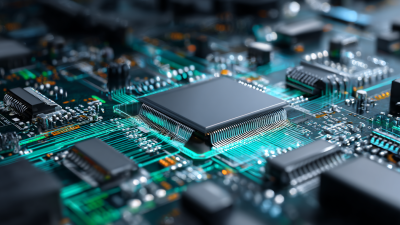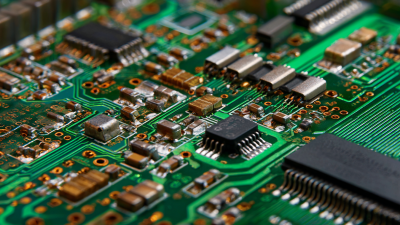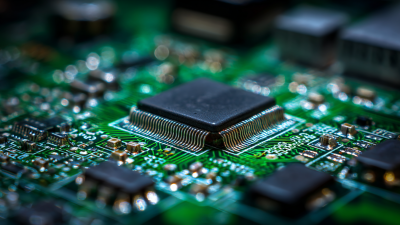Mastering Circuit Board Design Fundamentals for Beginners in Electrical Engineering
In today's fast-paced technological landscape, mastering circuit board design is essential for beginners in electrical engineering. As the demand for advanced electronic devices increases, the global printed circuit board (PCB) market is projected to reach USD 82.5 billion by 2026, growing at a compound annual growth rate (CAGR) of 4.6% from 2021 to 2026 (Mordor Intelligence). This growth signifies not only the importance of efficient circuit board design but also the critical role it plays in ensuring the functionality and reliability of electronic systems across various industries, from consumer electronics to automotive applications.

Circuit board design encompasses the intricate process of creating a PCB layout that integrates electronic components effectively, thereby enhancing performance while minimizing costs. According to industry reports, nearly 70% of design challenges arise from inadequate understanding of circuit design principles, which emphasizes the need for comprehensive education in this area. As engineers embark on their journey in electrical engineering, acquiring foundational knowledge in circuit board design is not only beneficial but indispensable for innovation and competitiveness in the field. By mastering these fundamentals, newcomers can contribute significantly to the evolution of technology and the design of more efficient, reliable electronic systems.
Understanding the Basics of Circuit Board Design for Beginners
Understanding the basics of circuit board design is crucial for beginners in electrical engineering. According to a report by the IPC, the global market for printed circuit boards (PCBs) is projected to reach $82 billion by 2024, highlighting the substantial demand for proficient design skills in this field. As applications in consumer electronics, automotive, and IoT expand, a solid foundation in PCB design becomes essential for budding engineers.
One of the fundamental aspects of circuit board design involves mastering schematic capture and layout techniques. Various software tools like Eagle and Altium Designer are widely used in the industry, providing functionalities that streamline the design process. A study by Research and Markets projected that advances in PCB design software would drastically reduce design time by up to 30% within the next few years, indicating the necessity for newcomers to familiarize themselves with these tools. Understanding the principles of signal integrity, power distribution, and thermal management will not only enhance the quality of their designs but also align with industry standards, setting them up for success in their careers.
Key Components and Their Functions in Circuit Board Design
In circuit board design, understanding key components and their functions is crucial for beginners in electrical engineering. The printed circuit board (PCB) serves as a foundational platform that interconnects various electronic components, enabling them to communicate effectively. Fundamental components such as resistors, capacitors, and integrated circuits each play specific roles; resistors limit current, capacitors store and release energy, and integrated circuits house complex functionalities in a compact form. Mastering the arrangement and interaction of these components is essential for creating efficient and reliable circuit designs.
Moreover, the advent of modern technology introduces additional components like connectors and power management ICs, which facilitate advanced functionality in devices. The integration of these components not only impacts the performance but also influences the manufacturability and longevity of the product. As the market for electronic devices, including those for electric vehicles, continues to expand, engineers must be adept in both the fundamental principles and innovative practices of PCB design to keep pace with industry demands and technological advancements. Understanding these key elements will empower new engineers to develop more sophisticated and efficient designs in their projects.
Mastering Circuit Board Design Fundamentals for Beginners in Electrical Engineering
| Component | Function | Symbol | Typical Values |
|---|---|---|---|
| Resistor | Limits current and divides voltage | R | 1Ω - 10MΩ |
| Capacitor | Stores electrical energy temporarily | C | 1nF - 100μF |
| Inductor | Stores energy in a magnetic field | L | 1μH - 10H |
| Diode | Allows current to flow in one direction | D | 1N4001 - 1N5819 |
| Transistor | Amplifies or switches electronic signals | Q | BC547 - 2N3904 |
Essential Tools and Software for Circuit Board Layout and Simulation
In the realm of electrical engineering, mastering circuit board design fundamentals is crucial for beginners aiming to excel in the field. One of the key elements of circuit board design is the utilization of Electronic Design Automation (EDA) tools and software, which have become essential for creating efficient layouts and performing simulations. Recent developments in the industry highlight the growing importance of these tools. For instance, a leading domestic EDA company introduced innovative design software optimized for schematic and PCB development, demonstrating a performance improvement of over 30% compared to established industry standards.
Moreover, the global EDA market has been expanding rapidly, with projections indicating growth from $9.78 billion in 2022 to $15.26 billion by 2026. This growth is driven by the increasing complexity of semiconductor designs and the need for more sophisticated design tools that can streamline workflows and enhance productivity. Advanced EDA solutions incorporate artificial intelligence to aid in circuit design, allowing engineers to accelerate their development cycles significantly. As more professionals embrace these tools, they contribute to elevating both the quality and efficiency of circuit board designs in a highly competitive landscape.
Common Design Pitfalls and How to Avoid Them in PCB Development
When embarking on the journey of printed circuit board (PCB) design, beginners often encounter various pitfalls that can significantly derail their projects. One common mistake is neglecting proper component placement. It’s crucial to ensure that components are placed in a logical manner, minimizing trace lengths and avoiding potential interference. Organizing components based on function and grouping related parts can lead to a more efficient design and easier troubleshooting down the line.
Another frequent issue is inadequate power and ground return paths. Beginners may overlook the importance of providing low-impedance pathways for power distribution, leading to voltage drops and potential circuit instability. It’s essential to use wider traces for power lines and to create solid ground planes to ensure that all components receive adequate power and maintain performance. By being mindful of these common design pitfalls from the outset, new engineers can create more reliable and efficient PCBs, paving the way for successful projects.
Best Practices for Prototyping and Testing Circuit Boards
Prototyping and testing are critical phases in circuit board design, especially for beginners in electrical engineering. According to a report by the IPC (Association Connecting Electronics Industries), approximately 69% of design engineers believe that testing and prototyping significantly reduce the risk of failures in production phases. This highlights the importance of meticulous iteration during the first stages of circuit board development. Utilizing tools like breadboards and PCB design software can streamline this process, allowing for quick modifications and immediate feedback.
Moreover, implementing best practices in testing can enhance the reliability of the final product. A study conducted by the IEEE found that nearly 50% of circuit board failures can be attributed to inadequate testing. Techniques such as Design for Testability (DFT) can help identify potential issues early on. Additionally, using automated test equipment allows for consistent and repeatable test results, ensuring that the circuit performs as intended under a variety of conditions. Embracing a structured approach to prototyping and thorough testing not only mitigates risks but also fosters innovation in circuit board design.
Related Posts
-

The Future of Electronics: How Flexible Printed Circuit Boards are Revolutionizing Device Design
-

Understanding the Essential Role of Printed PCBs in Modern Electronics
-

Exploring the Advantages of Aluminum PCBs in Modern Electronic Design: A Complete Guide
-

How Printed Circuit Boards Shape the Future of Technology with Insights from Industry Trends